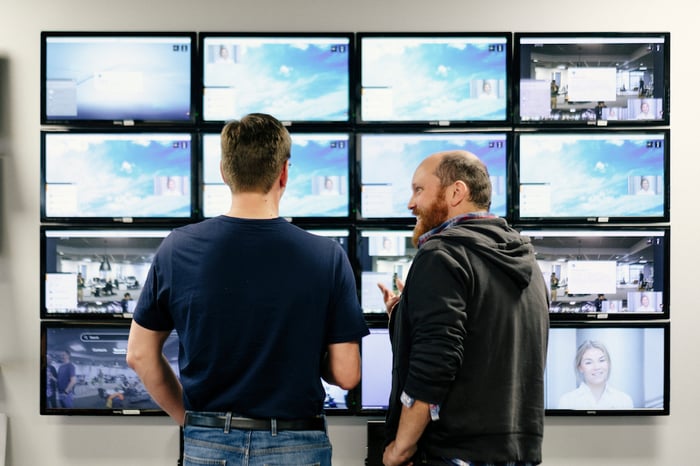COVID-19 has turned the world on its head. While workplace modernization was already taking hold, the trend has accelerated overnight as organizations moved to entirely remote workforces. This required swift digital transformation and mass adoption of video conferencing. In the rush to keep operations running during the outset of the pandemic, most scrambled and adopted anything just to keep employees connected and business functioning.
However, they recognized video can ensure remote employees feel connected and have a sense of community. They can communicate effectively internally and externally with employees in the office, at home or from other organizations. Now, as organizations address the new reality and plan for the future, they are stepping back and asking:
- Are we using the right tools to enable remote workers?
- Do these tools adhere to our privacy and security policies?
- Do these tools adhere to our customers’ expectations of data privacy?
- What does it mean to return to the office?
Scaling to unprecedented levels overnight
When organizations sent employees to work from home, many cloud video service providers experienced a massive influx of new users. Software as a Service (SaaS) providers were not prepared to handle the sudden change in demand, and as a result, users experienced serious connectivity and quality issues, which the providers scrambled to address.
Similarly, organizations managing their own private cloud on-premises, were swamped with the need for more compute and hindered by the speed at which they could procure more servers and turn up the equipment in the right locations. Quality was equally hampered.
Those leveraging the scale and depth of virtual private clouds running in Infrastructure as a Service (IaaS) offerings from vendors like Microsoft Azure, Google Cloud Platform (GCP) and Amazon Web Services (AWS) also needed to scale their applications. They were able to control how they optimized their application as they scaled to meet the unique needs of their users and business objectives, independent of both the constraints of running their own data centers as well as shared experience of a SaaS service.
As we have seen, each of these video conferencing deployment options has pros and cons.
When evaluating the best fit for your organization from a business continuity perspective as well as data privacy and security perspective, how can you determine the best deployment option for you?
Video conferencing is a critical piece of business continuity planning
Enterprises, government agencies, and healthcare organizations around the world rely on Pexip as a critical part of their business continuity planning. They recognize that high-quality video communications are a mission-critical tool that allows their workforce to keep humming from any location so they can continue running their business.
For those that are new to video conferencing and have had this digital transformation thrust upon them, a question we have been hearing over and over is, “what are my video conferencing options?” Especially when...
"I am a law firm and need to keep my offices around the world connected.”
"I am a health care provider and want to enable remote patient visits to protect my clinicians and the public.”
“I am a bank and I need to keep my business running while tens of thousands of employees are all working from home.”
A second, and perhaps even more critical part to this question, is:
“I also have very stringent privacy and security requirements. Do I need to sacrifice them in order to connect my team?”
COVID-19 has highlighted three key lessons for IT leaders:
-
The need for a business continuity plan
-
How video conferencing is a mission-critical tool that needs to be a part of that plan
-
Privacy and data protection need to go hand in hand with 1 and 2 above
Cloud Your Way: 3 deployment options to consider
Public Cloud: Software-as-a-Service (SaaS)
SaaS-based video solutions (commonly referred to as cloud video services) are shared public cloud offerings which are very popular today because of their simplicity and ease of deployment. IT teams can get an organization-wide solution up-and-running fast.
SaaS solutions help simplify IT by providing video conferencing as a utility-based service over the internet.
Most SaaS services offer global footprints, but not all SaaS offers are built the same. Depending on the provider and their area of expertise, they may specialize more or less on high-quality video and the complexities of providing a solution that can handle the demands of a globally distributed video conferencing service.
There are a lot of benefits of a SaaS-based service, but it’s important for customers to ensure they understand the privacy and security policies. We are all familiar with “clicking to accept” the privacy policy of consumer apps on our mobile devices. We knowingly exchange our privacy in the name of convenience. The calculus for this is very different for an organization that needs to protect its intellectual property, health records, and privileged client information. Pexip takes data privacy very seriously, and you can see our privacy policy here. It's important to understand a providers’ business model and the potential impact on your data.
Also, the recent mass transition to working remotely put a lot of stress on shared public cloud services. As one customer said, “shared service = shared pain.” While this is not unique to any one SaaS vendor, (Pexip saw its SaaS service increase by 700%), customers must evaluate if they can accept being one of many in a shared service. Often organizations that need to have a greater level of control for mission-critical applications tend to evaluate alternatives to SaaS-based offers. When determining whether a SaaS-based offering is a good fit, here are a few areas to consider:
- What is the privacy policy?
- What is the data security model?
- What SLAs does the provider offer?
- What is the global footprint of SaaS provider?
To learn more about how to evaluate the security and privacy of a cloud service, read my colleague Peng Mok’s post.
To learn about Pexip’s cloud video service, please click here.
Virtual Private Cloud: Infrastructure as a Service (IaaS)
Many organizations have a multi-cloud strategy leveraging both SaaS-based services as well as managing other applications themselves in an IaaS environment. IaaS is not a term unique to video conferencing, however, video conferencing applications that are designed for self-hosting on IaaS platforms are unique. Pexip calls its approach to IaaS, “self-hosted.”
IaaS gives an organization control over the video conferencing application and their data without the headache of building, deploying, and managing data centers. With IaaS-based deployments, the privacy policy is now in the control of the customer. They own and operate the application, and they own and control access to all data.
IaaS enables the customer to easily scale up and down to handle changes in requirements or spikes in demand, as is often the case with most business continuity plans. IaaS providers such as Microsoft, Google, and Amazon have large global footprints to ensure there is a data center available in most major metro areas, in addition to global resilient networks with large numbers of points of presence (PoPs) near offices. Remote users bypass a majority of the internet and traverse the IaaS backbone, providing greater quality and security. They also allow organizations to peer directly, providing secure, high-quality connections independent of the internet. Lastly, IaaS providers have large teams focused on the security architecture of the platform, offloading much of this workload from the enterprise.
If you are considering a self-hosted, IaaS environment, you should ensure the solution provides the tools to easily deploy, scale and manage the software. Just as security needs to be built in from day one, design for IaaS-based deployments is an architectural consideration from the beginning.
IaaS tends to be an option of choice for customers that want to control their ability to scale during times of need and have stringent requirements to maintain control over their data and privacy needs. IaaS provides a cloud option for many organizations managing the transition from on-premises to cloud and allows them to retain control while simplifying physical data center operations. When determining whether an IaaS-based video conferencing solution is a good fit, here are a few areas to consider:
- Do you have data privacy or regulatory requirements that prevent you from using a public shared SaaS service?
- Who is the IaaS vendor, what is their data center footprint, and what SLAs does it offer?
- Do you have in-house IT staff familiar with IaaS who can manage the roll-out and ongoing support and maintenance?
- Is the video conferencing application written for IaaS and does it support multi-cloud?
To learn more about Pexip’s self-hosted video conferencing application, please click here.
Private Cloud: On-Premises
This option provides the highest level of control, often required in highly-regulated industries with strict security and compliance needs, and in government environments with closed networks. Organizations who select this option should have robust IT departments with the ability and resources to build their own data centers and provide the necessary support. This option is for customers that have a “vertically-integrated” approach to their business continuity plans from application through data center operations and network access.
As with IaaS, on-premises based deployments put the customer in control of the data and privacy considerations.
The customer is responsible for deploying and managing the video conferencing application, therefore, as with IaaS, it must have administrative capabilities designed for running as a virtual machine in the customers datacenter on their servers. These tools should allow for ease of deployment, scale, and upgrades, in addition to the day-to-day management and maintenance.
One challenge with an on-premises approach is the need to scale up and down quickly. On-premises solutions require the customer to deploy the hardware necessary to accommodate their planned peak load. Pexip is unique in that it allows organizations to augment their on-premises deployments with IaaS-based resources for enhanced scaling. Multiple IaaS vendors are supported in a single deployment, providing an unmatched degree of fault tolerance. When determining whether an on-premises video conferencing solution is a good fit, here are a few areas to consider:
- Do you have a data center operations team capable of supporting video conferencing?
- Do you have data center server resources that meet the video conferencing application needs?
- Is the video conferencing application written for an on-premises installation?
- Does your video conferencing application provide a hybrid IaaS option?
To learn more about Pexip’s on-premises video conferencing application, please click here.
Pexip can help
Pexip is unique in that it offers all three deployment options as well as the hybrid on-premises – IaaS combination for unmatched flexibility. Pexip saw early on that there was a divergence of SaaS and on-premises offers and realized customers were being forced into decisions that may have been right for product developers but did not meet all customers’ needs. Pexip saw an opportunity to enable moving between these models in a way that evolves with the customers’ operational needs, rather than forcing customers into one choice or the other.
The Pexip Infrastructure supports the three main IaaS providers, Microsoft Azure Virtual Machines, the Google Cloud Platform (Google Cloud Engine - GCE) and Amazon Web Services (Amazon Elastic Compute Cloud – EC2).
As stay-at-home orders lift and remote workers return to the office, now is the perfect time to evaluate your long-term video conferencing needs. Pexip can help you understand which deployment option best suits your needs. To schedule an introductory meeting, please get in touch here.
- Meet & collaborate securely





